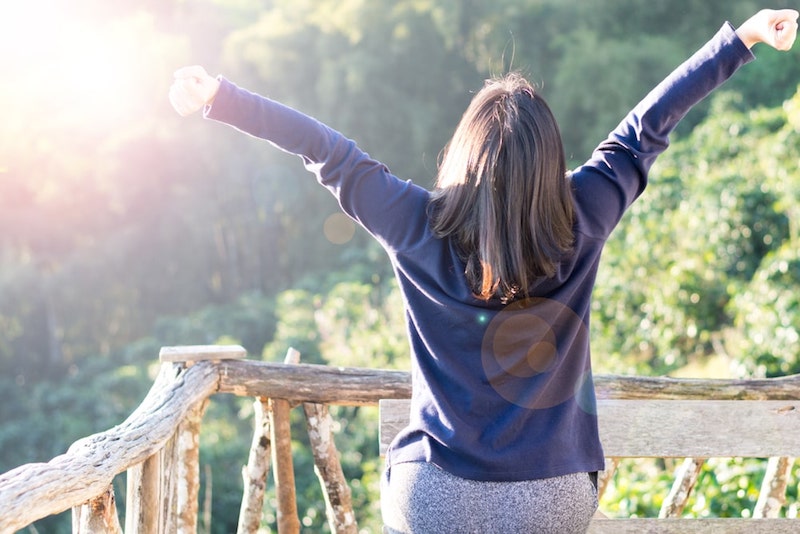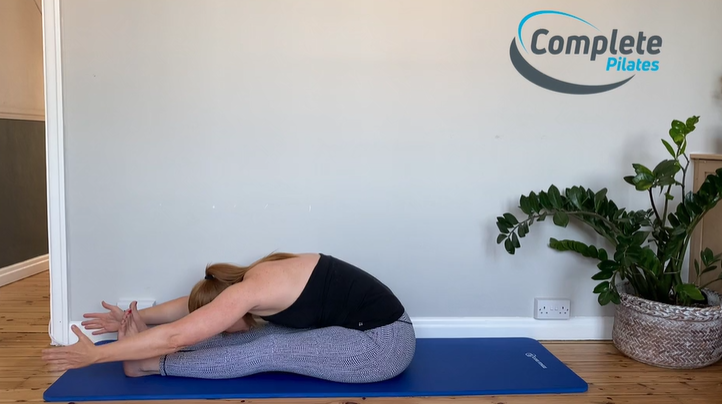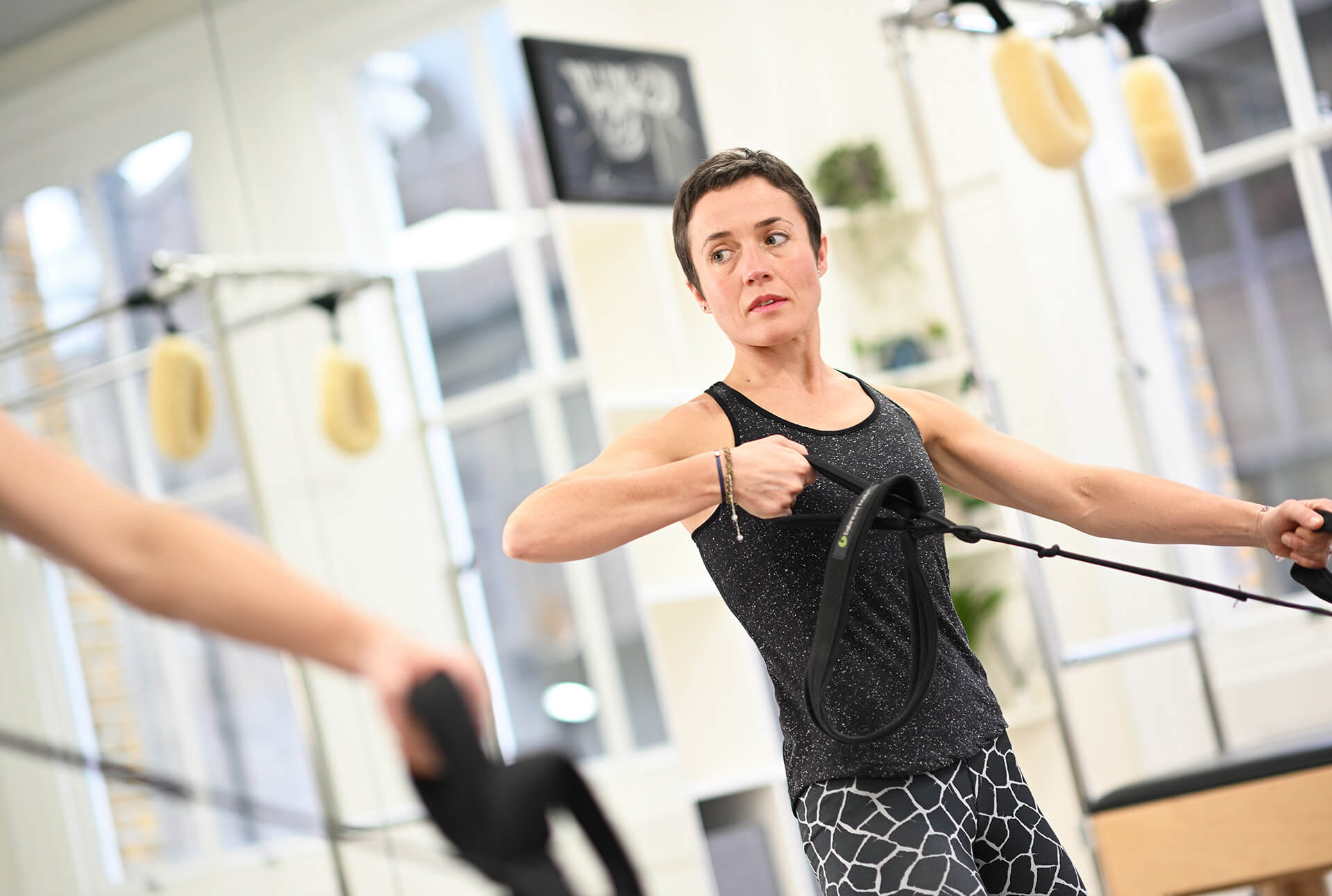Key Contributor: Roxy Morgan, Clinical Pilates Instructor, Sports Therapist
At Complete Pilates, we are often asked whether clients should be stretching more and what the benefits of stretching are.
Pilates and stretching are very much interlinked due to the focus in Pilates on mobility, breathing and flow.
Incorporating stretching into your daily routine as well as throughout your exercise can help improve flexibility, range of motion, posture, performance and mental health.
In this article we discuss the benefits of stretching, the types of stretching, the limitation of stretching and how it really works.
Quick Summary
- Pilates vs Stretching: Pilates and stretching are complementary, with Pilates incorporating active stretching to build both strength and flexibility, creating a strong foundation for overall fitness.
- Benefits of Stretching: Stretching has multiple benefits, including increased flexibility, enhanced range of motion, improved sports performance, better posture, and stress relief. It naturally supports blood flow, flexibility, and joint movement, contributing to overall physical and mental well-being.
- Types and Techniques of Stretching: Different stretching techniques, such as static, dynamic, and PNF stretching, serve specific purposes. Dynamic stretching is recommended before exercise to prepare the body for movement, while static stretching is better suited for post-exercise to aid recovery.
- Effective Stretching Practices: To achieve significant flexibility gains, static stretches should be held for at least 30 seconds and repeated multiple times daily. Dynamic stretches help warm up muscles and enhance performance, while mindful stretching can reduce stress and improve mental health.
Is Pilates Good for Stretching?
Stretching is good for you, it’s something we do naturally without thinking about it and it is very good for your body and mind. Imagine you have been sitting still for a while. You will naturally reach up, perhaps arch your back, and take yourself into a different posture. But not only that, when stretching your body releases serotonin. This hormone is known as a mood stabiliser, it aids stress reduction and thus, reduces feelings of depression and anxiety, leaving you in a better mental state overall.
We’re often asked whether Pilates is better than stretching. It’s not the case that one is better than the other, rather Pilates and stretching go together, hand in hand.
Pilates is a very versatile form of exercise that promotes a range of positive changes to the body, with improved flexibility and mobility being one of them. If you don’t already stretch as part of your regular routine, it is a great way to introduce it. Stretching through Pilates is often done via active stretching, which is considered a more effective version of stretching.
The key principles of Pilates include breath and flow. This style of movement helps promote relaxation through movement and allows for a reduction in guarding that can often happen during forced or uncomfortable stretching.
As Pilates movements involve a number of muscle groups, Pilates can be more effective than isolated stretches. You may find that exercises such as the seated spine stretch and the saw can help to stretch the back, hips, and hamstrings simultaneously.
Furthermore, Pilates Equipment can help create different positions and tension levels for each individual, allowing for a more personalised stretch depending on the limitations of each person.
Benefits of stretching and why do we stretch?
The natural stretches we do without even thinking are a reaction to keep our body healthy.
Our bodies do this to maintain good blood flow to your muscles and other soft tissue. It also helps maintain flexibility in your muscles and movement in your joints.
Humans were not built to sit still all day and maintain static postures. Instead, we were designed to move regularly, in a variety of ways.
To keep our body functioning at its best, we need to ensure we are taking our joints and soft tissue through their full range.
At Complete Pilates, we often talk about the strength required for this. Stretching can help as well, but the balance of stretching and strength gives us the best results.

How long should you hold a stretch?
This is the next question we often hear and as always depends on your goals. The answer will also be different depending on the type of stretch.
To get a change from doing static stretches you have to hold the stretch for at least 30 seconds. You must repeat it 3-4 times and do this at least twice a day. That is a lot of stretching for each muscle group!
When we are looking at the adaptability of the muscle and nerves together, we don’t have to do things for as long to get a change. If you are doing dynamic stretches to warm up you might see changes after moving your arm or leg just a few times. This is due to the adaptability of the nerves.
Below, we look at different types of stretching, including static and dynamic stretches.
When should you stretch?
There has been a lot of research into different types of stretches and whether you should be doing them before or after exercise.
The general rule is that your warmup should consist of dynamic movement to prepare your body for action. This should involve taking your muscles and joints through their full range and not holding static stretches!
This is for two main reasons. Firstly, the best preparation for movement is not to hold your body still -this should be obvious! But we still see lots of people doing it before exercise. This isn’t only as individuals; you see it being taught by exercise and health professionals as well!
Secondly, there has been research to show that for a period of time after static stretches the power of certain muscle groups reduces. This has been shown in the quadriceps muscles of jumping athletes (1). Consequently, static stretches should be kept for after exercise, or for a different time to exercise!
What actually happens inside the muscle when it stretches?
Muscles have a fixed point where they attach to the bone at either end. Consequently, what we DON’T change, is the physical length of the muscle tissue. What we CAN change, is the functional length of the tissue.
Muscles are made up of sarcomeres (bundles of muscle tissue) which are overlapping. As you stretch the overlap becomes less. Once the sarcomeres have reached their full potential, you then get stretching of the connective tissue around the muscle.
It is thought that some, but not all, of the sarcomeres stretch, and the more you stretch, the more sections of the muscle will contribute to your range of movement.
You do not actually change the length of the tissue, just the adaptability of it. However, this also relies on the adaptability of your nervous system.
Your nervous system is ‘plastic’, which means it adapts to what we do on a regular basis.
As an adult, if we are trying to gain flexibility and range of motion, static stretching alone will not do it. The length of time we would need to hold static stretches to make a change in the length is very difficult to achieve.
Functional improvements in flexibility and range of motion can only be achieved when combined with strength, movement quality and technique when looking at sports.
Now that we understand this, below we will have a closer look at five of the benefits of stretching.
The 5 benefits of stretching

1. Increased Flexibility
Flexibility is the ability to move your body with freedom and is an important component of physical fitness.
If you are unable to reach your arm overhead, or unable to crouch right down because you do not have enough flexibility in your tissues, this will limit your quality of life.
As we age, we tend to naturally stiffen in our tissues. This means that it is vital to maintain flexibility so we maintain our function.
Equally, for athletes to be able to achieve their full potential, they need to have adequate flexibility to get to the positions their sport demands. A combination of stretching the tissues and strengthening them to be able to hold that range, and come back from it, will help this.
Stretching and strengthening work together to give your body the ability to not only have flexibility when stretching, but to use it effectively in your sport or daily activities. It is not about being able to touch your toes!
This flexibility and freedom of movement is important for everyone, young, old, sedentary and active, to achieve full physical health and wellbeing.
You might be wondering how much you should stretch to get flexible, it is important to do so regularly, either everyday for shorter periods of time or a few times per week for longer i.e 20/30 minutes.
2. Increased range of motion
With flexibility comes range of motion. Range of motion is about how far your joints can move.
Do you often complain that your joints feel stiff or achey?
If we were to look at your joints on an x-ray, we often find that there are no changes whatsoever to the actual joint surface, even though they feel stiff.
This feeling of stiffness is not true joint stiffness, but more the result of the lack of flexibility and strength around the joint. Without the soft tissues and muscles functioning well, the joint itself will not be able to move fully through range.
To achieve full range of motion of your joints, and to be able to use it functionally, the muscles and connective tissues need to be able to lengthen and work effectively throughout that length.
Stretching can help to give you increased range of motion by giving you the full potential of your tissues.
So whether you are trying to get full back and shoulder movement for your tennis serve, or just be able to reach the top shelf, stretching could help you.
In physiotherapy, and the Complete Pilates studio, we often look at the passive range of joints versus the active range. If the joint itself is actually stiff from arthritic changes or injury the passive range will be reduced.
We can tell from our passive assessment whether there is also a restriction from the soft tissue and nervous system. We then compare this to the active range, which tells us more about what strength you have to take the joint and muscle through range.
In long sitting, how far forward can you reach? Can you then replicate that in standing? This is the difference between flexibility and strength through range!
Ruth can’t achieve the same range of motion actively because she doesn’t have the strength in this range. Knowing, and understanding this, allows us to effectively target your treatment and exercise selection to get the best benefit.
This is really important for everyone, as our ranges of motion and flexibility are different.
3. Improved sports performance
Ultimately, this is what athletes are looking to achieve from all parts of their training, whether it be technique, sports specific drills, strengthening, or stretching.
So how does stretching help to improve sports performance? There are a couple of different reasons why stretching can help.
Firstly, it is one of the factors that helps you warm up and prepare your body for action.
When our body is not prepared for movement, we do not perform as well and can potentially increase our risk of injury.
If you use dynamic stretching as a component of a warm up before sport, it prepares your body so that it is not shocked, and can be ready for action to its full potential immediately.
This is the same for all the body systems including your heart and circulation, the nerves that signal to the muscles, joint movement and proprioception as well as the actual flexibility of the muscles.
It literally gets us ‘warm’ and ready for action.
Secondly, the effect of the increase in flexibility and range of motion as described above, allows you to perform to your full potential.
For example, a gymnast needs to be able to easily get in and out of the splits. This means they need to be able to get into positions at the end of their range of motion to be able to compete!
But this applies to all sports and activities. If your body can get into the required positions with ease, then you are likely to perform better.
4. Improved posture
Posture is important for a number of reasons. The principles of Pilates include mobility, dynamic alignment, control, and co-ordination. All these will factors contribute to posture.
We often hear people talking about static postures like how to sit. However, posture should be an ever changing position and we should move before we feel stiff.
Try this! How far can you lift your arms overhead when you are slumped versus when you are upright?
Did you notice that she did not move her arms, just changed her spine’s position?
Better posture as we age can give us a better quality of life. This is due to being able to do all the things we want to continue to do and links in with sports and ability to do our everyday tasks.
Posture relies on our muscles and joints having the ability to get to the ideal position. Consequently, the flexibility and range of motion help to give us good posture.
Stretching can help us to achieve this by reminding the body regularly where the ideal position is and ensuring that our muscles, connective tissues and joints can get there, and hold us there!
As always this has to come hand in hand with the strength, otherwise we will be able to achieve good posture but not maintain it.
However, with all of this remember, your best posture is your next posture!
5. Helps to relieve stress and calm the mind

Exercise in all forms has been shown(2) to help relieve stress and calm the mind.
Static stretching can be an important part of this as it allows you to focus on one particular area of the body and take your attention out of your head and into your body.
This is a form of mindfulness and can give you a mental break from whatever else is going on at home or at work.
Breathing can help with stretching due to the activation of the sympathetic nervous system as your exhale. This can be combined with the breathing techniques you may use to meditate or relax.
Try focusing on the breath and imagining it going to the area you are trying to stretch. Even if it is a part of your body far away from your lungs, this can be a useful technique to take your attention to the breath and the area you are stretching.
Muscles can respond to emotional and physical stress, it is our natural fight, flight or freeze response. Mindful stretching can help to reduce stress levels and calm the mind, in turn helping to relieve this physical tension.
This is important to consider, as an increase in tension as a response to emotional stress can contribute to pain and reduced activity levels. It is one of the things we consider when we see our clients, and one of the reasons we might include stretching in a program.
If you know that stress causes an increase in tension anywhere in your body this may be a reason to stretch.
Types of stretching techniques
When we talk about stretching we need to be clear about what type of stretching we mean. There are a few different types and they do different things and should be used at the appropriate time.
There are two main types of stretching: dynamic and static. Dynamic stretches will involve movement and static will include holding a position.
Static stretching
Static stretching can be broken down into three types of stretches:
- Passive stretching – this is when you use another body part or someone else to push you into a stretch whilst the area you are stretching is relaxed. Consider the classic hamstring stretch when you sit with your legs in front of you and reach to your toes. You are using your torso, upper body, and a bit of gravity to feel a stretch in the back of your legs.
The muscles that you are trying to influence are not active. They are at rest and being pushed to end range passively. To actually make a change in the length of your muscle in this way you have to hold the stretch for a long time. You need to hold for at least 30 seconds 3-4 times twice a day for each muscle group to make a difference.
There are times when a passive stretch will be needed; In recovery from an injury where your muscles have been kept in a shortened position in plaster or a brace; in combination with more dynamic approaches and strengthening work. Passive stretches alone are unlikely to give you the outcome you are looking for in most cases.
Also remember what we mentioned earlier in the article about the possibility of them reducing power output in some groups. This is why it is advised not to do them before exercise, save them for afterwards or separate to exercise.

- Active stretching – It is still a static hold but is achieved by activating the opposite muscle to the one you are trying to stretch.
An example of this would be to lift your leg up in front of you, as we saw in the video earlier, to get a stretch through your hamstrings rather than sitting down and reaching for your toes. This activation of the muscle on top of the legs, the quads and the hip flexors helps to relax the muscles underneath the leg, the hamstrings. This is called reciprocal inhibition. When one muscle contracts the opposing muscle relaxes to allow the movement to take place.
This is one of the reasons we talk about strength being so important. You need to be able to effectively contract and work the muscles against gravity, body weight and more to function normally. This strength of contraction will help to enable the opposite muscle to relax and therefore ‘lengthen’ to give you more range.
It is a combination of strength and stretch.
- PNF stretching
PNF stands for proprioceptive neuromuscular facilitation. That is a scientific way of saying activating the nerves and muscles together to allow more movement. It can involve activation of both the muscle you are trying to stretch (the agonist) and its opposite (the antagonist).
Muscles achieve better relaxation of their fibres after a full contraction so we can utilise this to obtain more range of movement. This is because the proprioceptive organs in the muscle are inhibited by the contraction. This gives you a window of opportunity to achieve more length without the muscle trying to contract against it. If we use the same example of a hamstring stretch we can see how it works.
If you contract the hamstring without moving the leg (isometric contraction) you can then get full relaxation of the hamstring fibres afterwards. In this case you could sit with your legs out in front and your knee slightly bent. Dig your heel into the ground and imagine you are trying to bend your knee but do not move the leg. Hold this contraction for 7-15 seconds, relax for 2 seconds, then take into the passive toe touch stretch. See if you can get closer to your toes by adding this contraction in. You should then relax for around 20 seconds before repeating.
This is effective because it is considering the full muscle and nerve complexity of how our bodies work. We are not one dimensional in function which is why passive stretching alone might not be working for you.
You can also add a contraction of the opposite (antagonist) muscle to get the benefit of the active stretch described above. In our example this would be adding a contraction of the quads and hip flexors to your hamstring stretch. We often do this without realising when we are in the stretch position.
Dynamic stretching
This is the term that we use most as physios and Pilates instructors to talk about stretches that include movement through range. This is the ideal type of stretching to be done before activity as we talked about earlier it helps to prepare you for action and literally ‘warm-up’ the muscles.
- Ballistic stretching
This is a type of dynamic stretch that involves fast bouncing movement at the end of range. It is using force or momentum of movement to try and push your body beyond its usual limit of movement. This is often seen in people warming up for activity but is not always recommended!
It is more risky than other types of dynamic stretching as it might push your tissues too far too quick and potentially cause injury.
The other problem with this kind of stretching is that it often has the opposite effect of what you are trying to achieve. Our bodies are amazing at protecting themselves. If your tissues detect that they are being pushed too far without being prepared they will respond to protect. The stretch reflex causes your muscles to actually contract, shorten and ‘tighten’ to stop you from pushing your joints too far.
- Dynamic stretching
So this is the ideal kind of warm up stretching to do before exercise. Prepare your body for action with gradually progressive movement taking you towards the end of range into the movements required for your sport or activity.
This works to get the blood flowing, the nerves that switch the muscles on activating and the muscle fibres contracting and relaxing effectively through their full range.
If we take the example of the hamstring, then you can do leg swings to achieve this. Ideally stand one leg on a step so that the other leg is free to swing forward and backward. Swing your leg forward and pull the toes up, swing it back and point the toes. Gradually increase the range of movement until you are lifting the leg to full range. You only keep going whilst you maintain the maximal range of movement, do not push into fatigue.
In this activity you are activating the hip flexors and quads to lift the leg at the same time as gradually increasing the stretch on the hamstring at the back of the leg.
You are also hitting two birds with one stone as when you swing back you are stretching the hip flexors and quads and activating the calf hamstring and glutes.
We must not forget the benefit of activating the muscles in our warm-up too! If you can do dynamic stretches and some muscle activation you will be winning! In our hamstring example this might be some bridging, squats and leg swings then you will be getting the best range of movement and preparing well for activity.
Pilates stretching exercises you can do daily
As always this will really depend on you as an individual and what your goals are. If you would like to have a bespoke programme for you please do get in touch and we can book you in for an online or face to face session with one of our physios or instructors.
Most people we see spend far too long sitting at a desk, or if you are like me right now on my ‘sofa desk’!
I have included three stretches which I think combat the desk shape, give you range of movement to walk and run and at the same time improve your posture.
1. Hip flexor in half kneeling
This is a stretch for your hip flexors and quads.
In half kneeling, you are stretching the side with your knee on the floor.
Tuck your pelvis under, feel the stretch on the front of your hip and thigh.
You can take your pelvis forwards to feel more stretch but don’t lose the tuck.
You can add in the arm lift to increase the stretch and include your torso and upper body.
2. Cat/cow
This is a stretch for your spine.
On all fours tuck the pelvis so that your tail bone is tucking under and pubic bone comes closer to your navel.
Let this movement go through the whole spine so that your back arches up and your head looks down.
Revers the movement so that the tail bone lifts towards the ceiling and your chest is lifting forwards.
3. Book openings
This is a rotation stretch for the spine and the front of the shoulders.
Lying on your side, slide your top arm along your bottom arm and turn your chest to the ceiling.
Open out the top arm to increase the stretch in your spine and chest.
You should keep your hips and legs facing forwards throughout and your head supported.
Is It Possible To Overstretch?
Stretching is an excellent way to increase the natural flexibility of the muscles. Muscles that are stretched within their normal range benefit from the stretching and can provide extra support for your joints. However, if you push your muscle flexibility beyond that you run the risk of overstretching which can lead to injuries. To avoid overstretching simply stretch your body within its capacity for flexibility.
At Complete Pilates we would advise you to always speak to your doctor, physiotherapist, or clinical Pilates instructor here at Complete Pilates if you are worried about starting a new exercise regime.
Get in touch online or contact us on 0203 764 5668 for further information and / or advice!
What do our experts say?
Using Pilates equipment such as the reformer for stretching is brilliant. It is a great tool to be able to support you whilst you explore your range of motion. Being able to change the spring tension, can also create a more dynamic stretch. My personal favourite is the Mermaid on the reformer!
You can find us at one of our Pilates studios in London and speak to us about your needs. You can find us at Complete Pilates in Islington or any of our studios (see our Kensington Pilates studio or Complete Pilates in London City) for more information, please get in touch online or contact us on 0203 764 5668.
Research
(1)Effects of dynamic and static stretching on vertical jump performance and electromyographic activity. Hough et al Journal of strength and conditioning research March 2009
J sports med phys fitness 2003;43:21-7 Effects of running, static stretching and practice jumps on explosive force production and jumping performance W. B. Youngi, D. G. BEHM2
Journal of Strength and Conditioning Research, 2004, 18(4), 885–888 q 2004 National Strength & Conditioning Association – The effect of different warm-up stretch protocols on 20 meter sprint performance on trained rugby union players Iain M. Fletcher and Bethan Jones
(2) Exercise and stress reduction
TM Edenfield, JA Blumenthal – 2011 – psycnet
Education is key:
These blogs are designed to give information to everyone, however, it is important to remember that everyone is different! If you have not seen one of our therapists and have any questions about injuries, what you have read or whether this may be useful to you, please just ask. We are more than happy to help anyone and point you in the right direction. Our biggest belief is that education is key. The more you understand about your injury, illness and movement, the more you are likely to improve.





